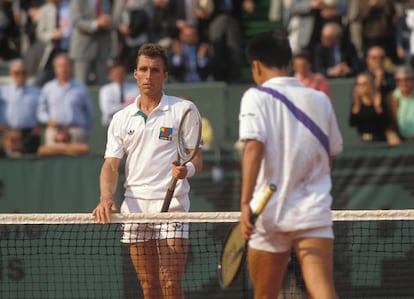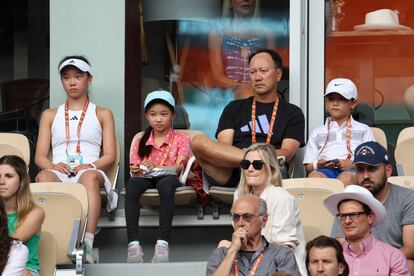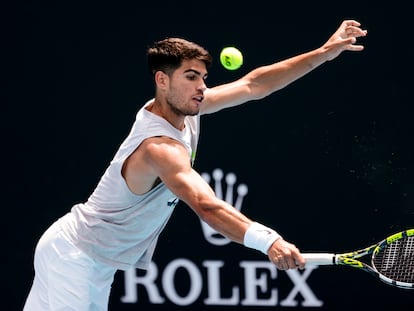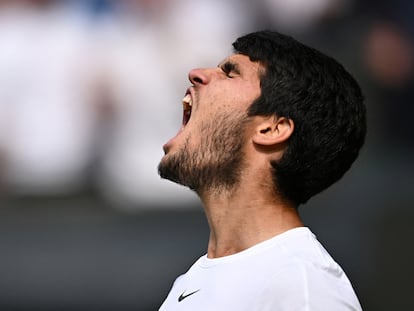Michael Chang: ‘Carlos Alcaraz is always smiling, whether he won or lost, and that’s not easy’
The American, the youngest winner of a Grand Slam tournament at the French Open in 1989, looks back to his transgressive underarm serve against Ivan Lendl and praises the Spanish player: ‘He’s an artist’

Amid the hustle and bustle of the subterranean Roland Garros museum, where former players of varying prominence parade while playing in the legends tournament, Michael Chang exudes tranquility and inner peace. He walks slowly, his hands in his pockets, with an imperturbable gesture under his baseball cap. He is asked for an autograph here, a photo there, and he complies without complaint. He graciously accedes to the request of EL PAÍS and travels back to 1989, when he won the French Open and in doing so became the youngest male Grand Slam champion aged 17 years and three months. During that tournament, he pulled off an unforgettable maneuver. During his fourth-round match against the feared Ivan Lendl — already cramping and trying to slow down the game — Chang delivered an underarm serve, which was within the rules but something nobody had previously dared to do on such a stage. The transgression worked and he would go on to lift the trophy after a five-set final lasting almost five hours against Stefan Edberg. In 1995, he lost in the final against Thomas “The Animal” Muster. Chang retired from tennis in 2003, with 34 career titles.
Question. Then, that serve was interpreted as daring, but today players like Moutet, Bublik, Davidovich or Kyrgios do it. Are you proud that they followed your example?
Answer. Actually, I only did it that one time in my entire career. And I did it because, honestly, I was desperate because of the conditions. At that time it was pretty rare for someone to do it, but I think now it has become more common, more of a strategy. Nowadays there are a lot of players who sit back far from the baseline to buy time on the return, so it’s a tactical resource; they have to make up all that ground, so depending on the situation, sometimes it makes sense.
Tennis at Roland Garros is similar to chess, because you have to understand the angles and the trajectories are differentMichael Chang
Q. Would you use it again if you were playing now?
A. I would definitely consider it, why not? I mean, if I saw a guy who was 15 feet behind the baseline, it could be very effective. I bet that 90% of the players on the tour, even many of them who have not used it, will have thought about it at some point, seeing the other guy so far back.
Q. What do you think of today’s game on clay? Everything is heading in the same direction, whatever the surface.
A. That’s right, but on clay everyone plays a little differently; even Rafa [Nadal] does it. He plays differently on this surface than on a hard court. Tennis here, you know, is similar to chess, because you have to understand the angles and the trajectories are different. Of all the surfaces today, this is probably the most different and unique of all. On grass, for example, it’s now very similar to hard courts, which are slower, and not like it was traditionally at Wimbledon; there’s hardly any serve-volley.

Q. Alcaraz is capable of playing well on any surface. What do you think of him? Do you think he is very different from what you see today?
A. When I see Carlos play, I tend to think that he is not the typical Spaniard. For me, it’s as if a kind of new generation of Spanish players has emerged, because the ones I competed against had great groundstrokes, they moved very well, they hit you with a lot of topspin balls and occasionally with sliced balls; for example, the Sánchez Vicario brothers used the slice a lot. Now, however, it’s different. You just have to see how Alcaraz attacks the net and how athletic he is. He’s very different from the classic prototype of the Spanish tennis player.
Q. Many experts say that he is a hybrid of Nadal, Federer and Djokovic. Do you agree?
A. Even he says it himself: “I have learned a lot from watching Rafa, Novak and Roger play.” And he’s absolutely right. You can see very clearly that he has learned a lot from watching those guys, and everything he has seen of them he has incorporated into his game. So it’s fun to see him on the court and it will be great to see how his tennis evolves in the coming years, when everything is going to be different because we’re seeing a new batch of players come through.

Q. What strikes you most about him?
A. You know, one of the things I really appreciate about Carlos is that he is able to go out there and act like a great champion; that is to say, he is capable of hitting all kinds of big shots. And, furthermore, even if you don’t know him at all as a person, after the game you can go say hello and you find a guy with a smile, whether he won or lost. Regardless of what has happened, he signs autographs or takes photos with the same attitude as always; and, honestly, I don’t think that’s easy at all, because great champions tend to focus on their own thing. I have always seen him with a smile on his face, however, and I think that’s great not only for himself, but for all tennis fans.
As a player, Carlos is an artist, a great talent; his potential is unlimited. It’s going to be interesting to see how it develops
Q. Is that the big secret, smiling and enjoying yourself?
A. I think that’s a big part of the reason why people like him so much. He gets along very well with the fans and, especially, with the kids. And as a player, he is an artist, a great talent; his potential is unlimited. It’s going to be interesting to see how it develops.
Q. He’s a hard-court specialist above all, but he also won Wimbledon and continues to improve on clay. How far can he go on clay?
A. I think he’s obviously going to get better and better. He missed a large part of the season, but in the end that may help him a little, because perhaps he will be fresher in this final stretch of the tournament. Sometimes, when you play too many games, you arrive here tired. When you’ve played four tournaments and won all four... It’s hard not to be tired, especially when you play three five-set matches every other day. So as long as he’s healthy and playing well, fitness won’t be an issue for him.
Q. Do you see him as champion this year?
A. I don’t know if he’s ready or not, but he certainly has a good opportunity ahead of him.
Sign up for our weekly newsletter to get more English-language news coverage from EL PAÍS USA Edition
Tu suscripción se está usando en otro dispositivo
¿Quieres añadir otro usuario a tu suscripción?
Si continúas leyendo en este dispositivo, no se podrá leer en el otro.
FlechaTu suscripción se está usando en otro dispositivo y solo puedes acceder a EL PAÍS desde un dispositivo a la vez.
Si quieres compartir tu cuenta, cambia tu suscripción a la modalidad Premium, así podrás añadir otro usuario. Cada uno accederá con su propia cuenta de email, lo que os permitirá personalizar vuestra experiencia en EL PAÍS.
¿Tienes una suscripción de empresa? Accede aquí para contratar más cuentas.
En el caso de no saber quién está usando tu cuenta, te recomendamos cambiar tu contraseña aquí.
Si decides continuar compartiendo tu cuenta, este mensaje se mostrará en tu dispositivo y en el de la otra persona que está usando tu cuenta de forma indefinida, afectando a tu experiencia de lectura. Puedes consultar aquí los términos y condiciones de la suscripción digital.
More information
Archived In
Últimas noticias
There is as much life left to discover on planet Earth as that which is already known
Dozens presumed dead, around 100 injured in fire at Swiss Alps bar during New Year’s celebration
Is porn for women different from conventional porn? We spoke to those who make it
Cartagena de Indias is sinking: What can the city do to mitigate it?
Most viewed
- Reinhard Genzel, Nobel laureate in physics: ‘One-minute videos will never give you the truth’
- David King, chemist: ‘There are scientists studying how to cool the planet; nobody should stop these experiments from happening’
- Sinaloa Cartel war is taking its toll on Los Chapitos
- Oona Chaplin: ‘I told James Cameron that I was living in a treehouse and starting a permaculture project with a friend’
- The Interoceanic Train, the Mexican alternative to the Panama Canal











































